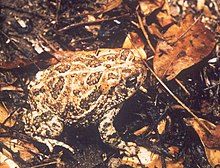The Great Plains toad (Anaxyrus cognatus) is a relatively large species of true toad native to central North America.
| Great Plains toad | |
|---|---|

| |
| Scientific classification | |
| Domain: | Eukaryota |
| Kingdom: | Animalia |
| Phylum: | Chordata |
| Class: | Amphibia |
| Order: | Anura |
| Family: | Bufonidae |
| Genus: | Anaxyrus |
| Species: | A. cognatus
|
| Binomial name | |
| Anaxyrus cognatus (Say, 1822)
| |
| Synonyms | |
|
Bufo cognatus Say, 1822 | |
Distribution
editThe amphibian is native throughout the Canadian Prairies (northern Great Plains) in southern Alberta, Manitoba, and Saskatchewan; and into northern Mexico in the Sonoran Desert and Mexican Plateau.[1][2][3]
Description
editThe Great Plains toad is grey, brown, and green in color, with darker colored blotching. It can grow to anywhere between 5.1 and 11.4 cm (2 and 4.5 in) in length. Its primary diet is various species of cutworms. It prefers grassland habitat with loose soil that is easy to burrow in. Breeding occurs throughout the spring and summer months, most often immediately after heavy rainfall. In dry areas it may only emerge from its burrow for a few weeks when conditions are right, and usually at night, but in areas with permanent water bodies and abundant rain it may be active all day.[4] Its mating call is a very loud, harsh chirping noise repeated many times, very fast.
Ecology
editThe great plains toad feeds a range of insects such as lepidopterans, dipterans, hymenopterans, coleopterans, ants, and termites. The toad is preyed upon by the plains garter snake (Thamnophis radix), among others.[3] It uses chemoreceptors to sense chemical cues left by the snake.
The great plains toad occur in deserts, grasslands, semi-desert shrublands, open floodplains, and agricultural areas. When inactive they burrow underground. Breeding takes place in temporary water bodies such as rain pools, flooded areas, and ponds; they can also use margins of reservoirs. The eggs and larvae develop in shallow water and metamorphose after 17 to 45 days.[1][3]
Conservations
editThe Great Plains toad has wide distribution and is not considered threatened, although it may suffer from road kills, farming, and suburban sprawl, increased droughts, and urbanization.[1]
References
edit- ^ a b c d IUCN SSC Amphibian Specialist Group (2022). "Anaxyrus cognatus". IUCN Red List of Threatened Species. 2022: e.T54612A196333146. doi:10.2305/IUCN.UK.2022-1.RLTS.T54612A196333146.en. Retrieved 2 December 2022.
- ^ Frost, Darrel R. (2016). "Anaxyrus cognatus (Say, 1822)". Amphibian Species of the World: an Online Reference. Version 6.0. American Museum of Natural History. Retrieved 5 February 2016.
- ^ a b c "Anaxyrus cognatus". AmphibiaWeb: Information on amphibian biology and conservation. [web application]. Berkeley, California: AmphibiaWeb. 2016. Retrieved 5 February 2016.
- ^ Grismer, L. L. (2002). Amphibians and Reptiles of Baja California. Los Angeles: University of California Press, 69.
Further sources
edit- Frost, D. R.; Grant, T.; Faivovich, J. N.; Bain, R. H.; Haas, A.; Haddad, C. L. F. B.; De Sá, R. O.; Channing, A.; Wilkinson, M.; Donnellan, S. C.; Raxworthy, C. J.; Campbell, J. A.; Blotto, B. L.; Moler, P.; Drewes, R. C.; Nussbaum, R. A.; Lynch, J. D.; Green, D. M.; Wheeler, W. C. (2006). "The Amphibian Tree of Life". Bulletin of the American Museum of Natural History. 297: 1–291. doi:10.1206/0003-0090(2006)297[0001:TATOL]2.0.CO;2. hdl:2246/5781.
- Pauly, G. B; Hillis, D. M.; Cannatella, D. C. (November 2004). "The history of a Nearctic colonization: Molecular phylogenetics and biogeography of the Nearctic toads (Bufo)". Evolution. 58 (11): 2517–2535. doi:10.1111/j.0014-3820.2004.tb00881.x. PMID 15612295.
- Herps of Texas: Bufo cognatus
External links
edit- Data related to Bufo cognatus at Wikispecies
- IUCN Red List.org: Anaxyrus cognatus (Great Plains Toad)
